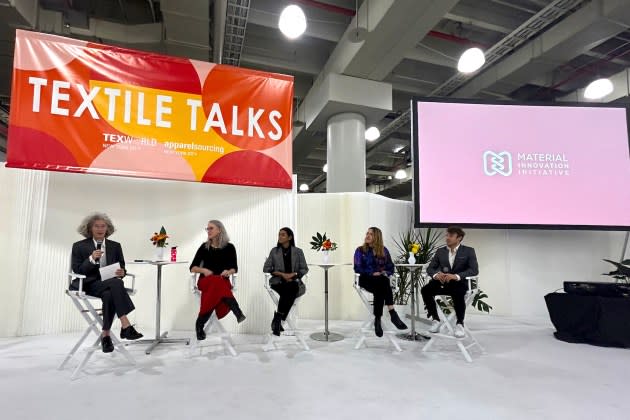Texworld NYC: Biomaterials Are ‘The New Class of Textiles’

By 2030, three out of four garments will be made from fossil fuels, according to Changing Markets Foundation. As such, the pressure is on bio-innovators to solve for the industry’s not-so-subtle reliance on polyester.
During the “Next-Gen Materials and Fiber Innovation: The Journey from Concept to Pilot Lab and Beyond” panel at Texworld NYC, moderated by Material Innovation Initiative (MII) material innovation and design director Thomasine Dolan Dow, speakers discussed their unique biomaterials, brand partnerships and the path from concept to development.
More from Sourcing Journal
Fiber Innovators Explore Next-Gen Silk, Inditex Debuts Jacket Made From Textile Waste
Material World: Melina Bucher Taps Mirum, Ligne Roset Works With Reishi
“Squitex is a protein fiber, and protein fibers are really polymers; all of your plastics, the technical name is polymers,” Julie Willoughby, advisor and interim CEO of Tandem Repeat Technologies, said, explaining the makeup of the Philadelphia firm’s novel squid protein material. “You can basically have a biopolymer or protein that has different segments: hard segments and soft segments. By manipulating where those segments are and engineering the protein sequences. . .you can dial in the functional property of that polymer.”
Kintra Fibers’ textile program manager Saloni Gupta explained what exactly biosynthetic means and how the biodegradable polyester startup makes its unique polymers.
“Traditional synthetics are fossil fuel driven,” she said. “Mainly petroleum is one of the building blocks of the chemical input—which is not biodegradable, it’s toxic to the environment. For Kintra, our chemistry is a composite of PBS—polybutylene succinate—which uses 100 percent biobased feedstocks as a chemical input,” Gupta said. “The building block is made out of sugars, for example, [which] makes it biodegradable as a biosynthetic.”
On the topic of interesting inputs, Jen Keane, co-founder and CEO of Modern Synthesis, discussed how the London-based biotech company employs microbes to grow a new form of textile made of nanocellulose, a strong and fine form of cellulose.
“When I was introduced to my co-founder, Ben, who’s a bioengineer at Imperial College, [he] had been looking at this bacteria for over a decade because of how efficient it is at producing nanocellulose that has these really interesting material properties on the fiber level,” Keane said. “But also it creates this really strong nonwoven structure that we can then make into a new class of textile.”
“I use that term ‘new class of textile’ [as] it really is different—it’s a new type of nonwoven material that allows us the flexibility of displacing or replacing materials like leather,” she said.
Meanwhile, Martin Stübler, co-founder and CEO of BioFluff, was inspired by his time at a leather tannery to develop a plant-based fur alternative, utilizing his extensive plant-centric education to do so.
“Plants have incredible properties, and the plant fibers are as diverse as plants themselves,” Stübler said. “Using different plant fibers in different applications is a thought that came very early to me, but was really just crystalized when I saw all these animals in the tannery being skinned for their fur. I was like, ‘Hmm, I wonder if we could make [fur] from plant fibers.’”
Turns out, you can. BioFluff’s Savian is made from 100 percent renewable plant fibers and agricultural waste, transforming nettle, flax and hemp into fur, shearling and fleece-like fabrics using proprietary technologies. And that technology caught the attention of Stella McCartney, who unveiled the first-ever coat using the vegan and plastic-free material at COP28.
“[Stella McCartney] has a fantastic innovation team; they’re in contact with us almost daily—we constantly shared updates, they shared feedback,” Stübler said. “For us as a startup, we needed [that] documentation. If there is no documentation, we cannot help.”
Modern Synthesis also has a luxury partnership under its belt, having collaborated with Ganni on a bacteria-based version of its iconic Bou Bag.
“I think one of the biggest challenges in our space is how to work with other companies and, particularly, brands; when you introduce something that’s completely new to these brands, a lot of the time, there isn’t the structure for embedding these new technologies into collections,” Keane said. “With Ganni, they have a program called ‘Fabrics of the Future’ and they’ve really been trendsetters in this space of working with startups like us to take us where we are and work with us to figure out how do we get this into products. These relationships are so critical.”
For Kintra, which has teamed with the likes of Reformation and Bestseller, partnerships require patience.
“These are magnificent people who understand and have the patience of working with innovators—it’s not a six month or a one-year project,” Gupta said. “These things take time. There’s multiple stages of testing, we are growing from experimental to pilot to demonstration to production levels—there’s patience required.”
But getting out of the lab and onto the market is not as simple as it sounds.
“I think my fellow startup founders understand that the key to making this transition to a more sustainable industry is scale,” Keane said. “What we’ve been doing is looking at how we can use existing infrastructure and machinery to make really cool materials.”
